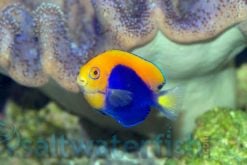Flameback Angelfish (Centropyge acanthops)
Quick Stats:
- Care Level: Moderate
- Temperament: Semi-aggressive
- Diet: Omnivore
- Reef Safe: No
- Minimum Tank Size: 30 gallons
- Max Size: 4 inches
- Water Parameters: pH 8.1-8.4, Salinity 1.020-1.025, Temperature 72-78°F
Comprehensive Guide – Flameback Angelfish
The Flameback Angelfish, scientifically known as Centropyge acanthops, is a beautiful and popular species in the saltwater aquarium hobby. This comprehensive guide will provide you with all the necessary information to successfully care for this species in your aquarium.
Habitat
The Flameback Angelfish is native to the Indo-Pacific region, specifically found in the reefs of the Maldives and Sri Lanka. It inhabits coral-rich areas with plenty of hiding spots and caves.
Reef Safe
The Flameback Angelfish is not considered reef safe. It may nip at corals and other sessile invertebrates, potentially causing damage to the reef environment.
Size
The Flameback Angelfish can reach a maximum size of around 4 inches, making it suitable for smaller to medium-sized aquariums.
Temperament
This species is known to be semi-aggressive. It may exhibit territorial behavior, especially towards other angelfish or similar-looking species.
Sexual Dimorphism
Sexual dimorphism in Flameback Angelfish is not easily distinguishable. Males and females have similar coloration and markings.
Lifespan
The average lifespan of the Flameback Angelfish is around 5 to 7 years, but with proper care, it can live longer.
Diet
In aquariums, Flameback Angelfish are omnivorous and require a varied diet. Offer them a combination of high-quality flakes, pellets, frozen foods (such as brine shrimp and mysis shrimp), and occasional live foods.
Aquascaping Recommendations
When setting up the aquarium for Flameback Angelfish, provide plenty of hiding spots and caves using live rock or artificial structures. This will help them feel secure and reduce aggression towards tankmates.
Captive Bred Availability
The Flameback Angelfish is occasionally available as captive-bred specimens. Captive-bred individuals are generally hardier and better acclimated to aquarium conditions compared to wild-caught specimens.
Compatibility with Tankmates
When choosing tankmates for Flameback Angelfish, it’s important to consider their semi-aggressive nature. Here are five specific tankmates that can be good choices:
- Royal Gramma: This peaceful fish adds vibrant color and occupies a different niche in the aquarium, reducing potential aggression.
- Firefish Goby: These small, peaceful gobies are active swimmers and can coexist well with Flameback Angelfish.
- Cleaner Shrimp: These shrimp not only serve as interesting tankmates but also provide cleaning services to the angelfish.
- Coral Beauty Angelfish: While caution is needed when keeping multiple angelfish, the Coral Beauty can be compatible if introduced together.
- Green Chromis: These schooling fish can help distract the Flameback Angelfish and reduce aggression within the tank.
These tankmates are just a few examples, and compatibility can vary depending on individual fish and tank conditions. Always monitor the behavior of all tank inhabitants and be prepared to make adjustments if necessary.
Other Common Names
The Flameback Angelfish is also known by other common names, including Flame Angelfish and African Pygmy Angelfish.
Why Buy from Reefs4Less.com
Reefs4Less.com is a trusted online retailer specializing in saltwater aquarium supplies. They offer a wide selection of high-quality fish, corals, and other livestock. With their expertise and commitment to customer satisfaction, Reefs4Less.com ensures a seamless shopping experience for all saltwater aquarium enthusiasts.
Popular Questions about Flameback Angelfish
Q: What is the ideal tank size for Flameback Angelfish?
A: The minimum tank size recommended for Flameback Angelfish is 30 gallons, but providing a larger tank will offer more swimming space and reduce territorial behavior.
Q: Can Flameback Angelfish be kept in a reef tank?
A: Flameback Angelfish are not considered reef safe. They may nip at corals and other sessile invertebrates, potentially causing damage to the reef environment.
Q: How often should I feed my Flameback Angelfish?
A: It is recommended to feed Flameback Angelfish small amounts multiple times a day. This helps mimic their natural feeding behavior and ensures they receive a balanced diet.
Q: Are Flameback Angelfish suitable for beginners?
A: Due to their semi-aggressive nature and specific care requirements, Flameback Angelfish are better suited for intermediate to experienced saltwater aquarium keepers.
Q: Can Flameback Angelfish be kept as a solitary fish?
A: While Flameback Angelfish can be kept alone, they may exhibit more natural behavior and thrive better when kept with suitable tankmates.
| Size | 1.25 – 2.25 inches |
|---|




Reviews
There are no reviews yet.